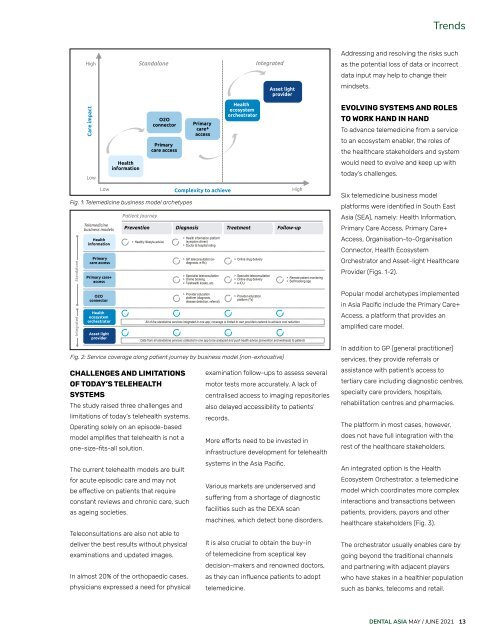Dental Asia May/June 2021
For more than two decades, Dental Asia is the premium journal in linking dental innovators and manufacturers to its rightful audience. We devote ourselves in showcasing the latest dental technology and share evidence-based clinical philosophies to serve as an educational platform to dental professionals. Our combined portfolio of print and digital media also allows us to reach a wider market and secure our position as the leading dental media in the Asia Pacific region while facilitating global interactions among our readers.
For more than two decades, Dental Asia is the premium journal in linking dental innovators and manufacturers to its rightful audience. We devote ourselves in showcasing the latest dental technology and share evidence-based clinical philosophies to serve as an educational platform to dental professionals. Our combined portfolio of print and digital media also allows us to reach a wider market and secure our position as the leading dental media in the Asia Pacific region while facilitating global interactions among our readers.
You also want an ePaper? Increase the reach of your titles
YUMPU automatically turns print PDFs into web optimized ePapers that Google loves.
C: Telemedicine business model archetypes<br />
Trends<br />
Addressing and resolving the risks such<br />
High<br />
Standalone<br />
Integrated<br />
as the potential loss of data or incorrect<br />
data input may help to change their<br />
Asset light<br />
provider<br />
mindsets.<br />
Care impact<br />
O2O<br />
connector<br />
Primary<br />
care access<br />
Primary<br />
care+<br />
access<br />
Health<br />
ecosystem<br />
orchestrator<br />
EVOLVING SYSTEMS AND ROLES<br />
TO WORK HAND IN HAND<br />
To advance telemedicine from a service<br />
to an ecosystem enabler, the roles of<br />
the healthcare stakeholders and system<br />
Low<br />
Health<br />
information<br />
would need to evolve and keep up with<br />
today’s challenges.<br />
Integrated Standalone<br />
Low<br />
D: Service coverage along patient journey by business model [non-exhaustive]<br />
Fig. 1: Source: Telemedicine Roland Berger business model archetypes<br />
Telemedicine<br />
business models<br />
Health<br />
information<br />
Primary<br />
care access<br />
Primary care+<br />
access<br />
O2O<br />
connector<br />
Health<br />
ecosystem<br />
orchestrator<br />
Asset light<br />
provider<br />
Fig.<br />
Source:<br />
2: Service<br />
Roland<br />
coverage<br />
Berger<br />
along patient journey by business model (non-exhaustive)<br />
CHALLENGES AND LIMITATIONS<br />
OF TODAY’S TELEHEALTH<br />
SYSTEMS<br />
The study raised three challenges and<br />
limitations of today’s telehealth systems.<br />
Operating solely on an episode-based<br />
model amplifies that telehealth is not a<br />
one-size-fits-all solution.<br />
The current telehealth models are built<br />
for acute episodic care and may not<br />
be effective on patients that require<br />
constant reviews and chronic care, such<br />
as ageing societies.<br />
Patient journey<br />
> Healthy lifestyle advice<br />
Teleconsultations are also not able to<br />
deliver the best results without physical<br />
examinations and updated images.<br />
Prevention Diagnosis Treatment<br />
Follow-up<br />
In almost 20% of the orthopaedic cases,<br />
physicians expressed a need for physical<br />
Complexity to achieve<br />
> Health information platform<br />
(symptom driven)<br />
> Doctor & hospital rating<br />
> GP teleconsultation (ediagnosis,<br />
e-Rx)<br />
> Specialist teleconsultation<br />
> Online booking<br />
> Telehealth kiosks, etc.<br />
> Provider education<br />
platform (diagnosis,<br />
disease detection, referral)<br />
> Online drug delivery<br />
> Specialist teleconsultation<br />
> Online drug delivery<br />
> e-ICU<br />
> Provider education<br />
platform (Tx)<br />
All of the standalone services integrated in one app; coverage is limited to own providers network to achieve cost reduction<br />
High<br />
> Remote patient monitoring<br />
> Self-tracking app<br />
Data from all standalone services collected in one app to be analyzed and push health advice (prevention and wellness) to patients<br />
examination follow-ups to assess several<br />
motor tests more accurately. A lack of<br />
centralised access to imaging repositories<br />
also delayed accessibility to patients’<br />
records.<br />
More efforts need to be invested in<br />
infrastructure development for telehealth<br />
systems in the <strong>Asia</strong> Pacific.<br />
Various markets are underserved and<br />
suffering from a shortage of diagnostic<br />
facilities such as the DEXA scan<br />
machines, which detect bone disorders.<br />
It is also crucial to obtain the buy-in<br />
of telemedicine from sceptical key<br />
decision-makers and renowned doctors,<br />
as they can influence patients to adopt<br />
telemedicine.<br />
Six telemedicine business model<br />
platforms were identified in South East<br />
<strong>Asia</strong> (SEA), namely: Health Information,<br />
Primary Care Access, Primary Care+<br />
Access, Organisation-to-Organisation<br />
Connector, Health Ecosystem<br />
Orchestrator and Asset-light Healthcare<br />
Provider (Figs. 1-2).<br />
Popular model archetypes implemented<br />
in <strong>Asia</strong> Pacific include the Primary Care+<br />
Access, a platform that provides an<br />
amplified care model.<br />
In addition to GP (general practitioner)<br />
services, they provide referrals or<br />
assistance with patient’s access to<br />
tertiary care including diagnostic centres,<br />
specialty care providers, hospitals,<br />
rehabilitation centres and pharmacies.<br />
The platform in most cases, however,<br />
does not have full integration with the<br />
rest of the healthcare stakeholders.<br />
An integrated option is the Health<br />
Ecosystem Orchestrator, a telemedicine<br />
model which coordinates more complex<br />
interactions and transactions between<br />
patients, providers, payors and other<br />
healthcare stakeholders (Fig. 3).<br />
The orchestrator usually enables care by<br />
going beyond the traditional channels<br />
and partnering with adjacent players<br />
who have stakes in a healthier population<br />
such as banks, telecoms and retail.<br />
DENTAL ASIA MAY / JUNE <strong>2021</strong> 13


















